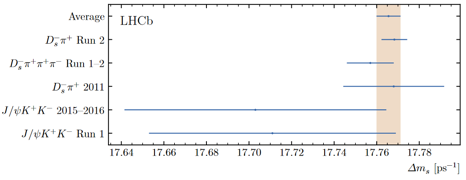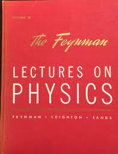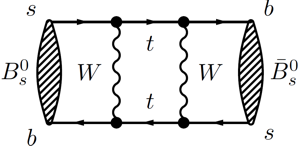Precise determination of the Bs0−Bs0 oscillation frequency.
“A phenomenon in which quantum mechanics gives a most remarkable prediction” – Richard Feynman
Today, the LHCb Collaboration submitted a paper for publication that reports a precise determination of the Bs0−Bs0 oscillation frequency. This result is presented also today at the joint annual conference of the UK Institute of Physics (IOP), organized by the University of Edinburgh. The Bs0−Bs0 oscillation is a spectacular and fascinating feature of quantum mechanics. The strange beauty particle B0s composed of a beauty antiquark (b) bound with a strange quark s turns into its antiparticle partner Bs0 composed of a b quark and an s antiquark (s) about 3 million million times per second (3*1012) as seen in the image below.

In order to determine if a neutral meson oscillated into its antiparticle the nature (flavour) of the Bs0 or Bs0 meson needs to be known both at its production and decay. The B0s particles have been identified through their decay into a charmed-strange Ds– meson and a pion, B0s→ Ds–π+, while Bs0 antiparticles through their decay with opposite charges, Bs0→ Ds+π–. The identification at the production is more complicated. A range of inputs is collected at the B0s production point and combined in a sophisticated algorithm in order to determine its nature (flavour). Of course, LHCb observes B0s particles and antiparticles only during their short lifetime in which they travel about 1 cm in the LHCb detector. The image above shows the oscillation pattern of events having the same nature at the production and decay in blue, and those, for which the nature has changed in red. In both cases a spectacular oscillation pattern is observed as a fuction of the Bs0 measured lifetime.
LHCb physicists measured precisely the oscillation frequency of these oscillation to be Δms=17.7683±0.0051±0.0032ps-1. A combination of this result with previous LHCb measurements gives the value of Δms=17.7656±0.0057ps-1. The image shows a summary of LHCb measurements. The excellent precision of the LHCb detector, particularly its Vertex Locator (VELO), allowed LHCb to obtain these results.
The neutral meson particle-antiparticle (matter-antimatter) oscillation was predicted by Gell-Mann and Pais in 1950es. They noticed that both the neutral strange meson K0, and its antiparticle K0, decay into a pair of pions, π+π–. Therefore a K0 meson can turn into K0 meson and vice versa following the reaction K0↔ π+π–↔K0. Thus the two particles, K0 and K0, should be considered in quantum mechanics as a single two-state system. The quantum mechanical treatment leads to the particle-antiparticle oscillation pattern. For experts: the quantum mechanical superposition of the neutral strange meson K0, and it antiparticle K0, leads to two neutral strange mesons each with their own mass and typical lifetime. A consequence of this coupled system is that the K0 meson can turn into the anti-K0 meson, K0, and vice versa. Richard Feynman explained the Gell-Man and Pais prediction, not confirmed experimentally at that time, on 9 pages in his memorable Lectures on Physics (Vol. III, 11-5) calling this phenomenon “a most remarkable prediction of quantum mechanics”. Gell-Mann and Pais could not predict the parameters of these oscillations since they did not know “internal mechanics” of K mesons. In the quantum mechanical two-state system, the Bs0−Bs0 system is described also as a system of two mass states, heavy and light. The oscillation frequency corresponds to the minute mass difference Δms between these two mass states, amounting to only 0.011 eV (or 2.1 x 10-35 g when converted to more conventional units).
Now we know not only the strange neutral mesons, but also charm, beauty and strange beauty neutral mesons. We know also internal mechanics of these mesons: the quark model and the Standard Model (SM) of particle physics. We can therefore calculate the frequency of these oscillations, as shown in the Feynman graph to the left. The Bs0−Bs0 oscillations have the highest frequency of all neutral mesons and the oscillations are the most spectacular. The oscillations B0-B0 are about 37 times slower; the oscillations D0-D0 are even slower and therefore only the first part of the oscillation period is observed experimentally, see 7 November 2012 news.
Even more; the oscillation frequency is measured and calculated so precisely that it provides one of the strongest constraints to models beyond the SM, that try to explain the observed flavour anomalies. For example, models with a new fundamental force Z’ could easily alter the Bs0 oscillation frequency.
The image of the Bs0−Bs0 oscillations is a beautiful visual example of the quantum-mechanical nature of our universe.
Read more in the LHCb paper and conference presentation. Preliminary results have been already presented at Les Rencontres de Physique de la Valée d’Aoste.



